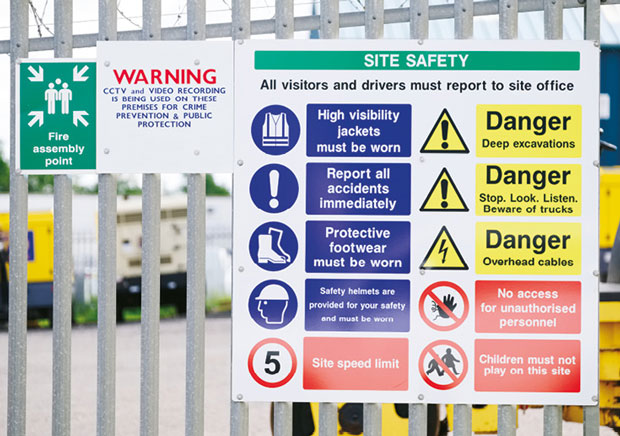 Safety signage isn’t the only way to promote health and safety. Effective communication of all types is crucial for workplace safety says Phil Pinnington, Head of Audit & Consultancy, British Safety Council
Safety signage isn’t the only way to promote health and safety. Effective communication of all types is crucial for workplace safety says Phil Pinnington, Head of Audit & Consultancy, British Safety Council
Facilities managers play a critical role in not just keeping operations running smoothly, but in creating a safe and legally compliant environment for everyone on site.
One vital element of workplace safety is effective communication. Whether that is through signage, verbal guidance or leadership, clear and consistent communication ensures employees understand safety standards, procedures, and potential hazards.
The 1996 Health and Safety (Signs and Signals) Regulations require employers in England, Wales and Scotland to provide and maintain safety signs where significant risks to health and safety cannot be avoided or controlled by other means.
But safety signage isn’t just about ticking a compliance box. It’s about clear communication. It protects staff, visitors, contractors and ultimately, your organisation by reducing confusion, preventing incidents, and reinforcing a safety-first culture.
Other regulations such as the Health and Safety at Work Act 1974 also include a duty of care to employees and members of the public, and to ensure compliance, employers must carry out risk assessments to determine what signage is required throughout a site.
There is, however, much more that employers can do to ensure the safety of their employees than provide signage.
SAFELY INFORMED
A key aspect of any plan to reduce the risk of accidents and injuries is providing information, instruction and training to all employees. Ensure clarity and consistency (using clear language and no jargon), so that all safety signage and messages are understood by all employees (remember to consider additional needs, addressing language barriers, literacy issues, or other needs that might affect an employee’s understanding of safety information).
Two-way communication helps foster a dialogue, encouraging employees to ask questions and raise concerns, which, in turn, helps to build transparency and trust by being open and honest about safety issues. Really build upon this transparency by establishing clear channels for employees to provide feedback on safety procedures and raise any concerns they may have. You will create a virtuous circle by using this feedback and other employee engagement to update your training, risk assessments, signage and emergency procedures, and tailoring this to specific roles or sites where appropriate, thereby actively involving employees in safety initiatives, decision-making, and hazard identification.
I’ve spoken to many senior leaders who confidently say they fully understand their responsibilities to protect the health and safety of their workers. For some, this knowledge has come from attending a health and safety for directors course, and these courses do provide directors and managers with a solid baseline knowledge of the key legislative requirements and the human and business benefits of health and safety.
H&S LEADERS
In fact, many of the leaders who attend these courses go on to become health and safety champions at board level – improving safety culture by driving, leading and cajoling efforts to ensure their business is both properly managing the risks and going beyond the minimum and achieving occupational health and safety (OSH) excellence.
But leadership, we are often told, is about actions as well as words. In the world of occupational health and safety, effective leadership must bring together the right balance of actions and words to help workers understand both the how and why of workplace safety.
Effective OSH leadership understands that no matter how inspiring our words might be, they cannot create an effective safety culture in isolation. Safety advice, pinned to office walls, rings hollow if it isn’t backed by consistent and visible actions, and these begin at the top.
Words and signs matter but they mean nothing in isolation.
When leaders walk past an unsafe act without comment, it sends a message louder than any safety briefing or signage ever could. Conversely, when leaders take the time to engage with workers on the ground, ask questions, listen to concerns, and address risks directly, they demonstrate that safety is not just a policy but a priority. It becomes policy in action, rather than policy inaction.
ACTIONS MATTER
Action without communication also falls short. A safety culture which changes procedures or introduces new safety protocols without exploring risks or resistance is bound to fail. We know that people are more likely to embrace change when they connect the ‘what’ they do with the ‘why’ they do it. Communicating the ‘why’ behind decisions allows workers to understand how their actions can impact others, for better or worse.
At its core, safety leadership is about influence, and influence depends on credibility. Workers look to leaders not just for basic training, signage and direction, but for signals: what’s tolerated, what’s encouraged, and what’s rewarded. Credibility is earned when leaders strike the right balance between actions and words, and it’s undermined when they say the right things but fail to follow-through.
Winning hearts and minds – improving your organisation’s safety and safety culture – requires more than signs, rules and reminders; it requires genuine authenticity seen through actions and words. When we get this right, people feel safe to speak up, report risks and suggest improvements. When we get it right, everyone benefits.
By implementing these principles, organisations can create a positive safety culture where employees are actively involved in maintaining a safe and healthy work environment.





